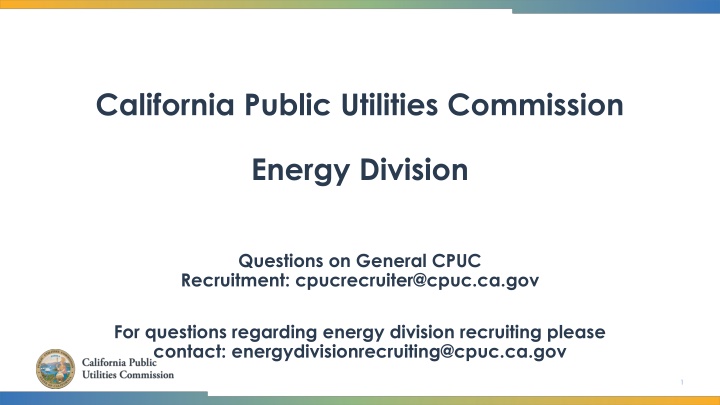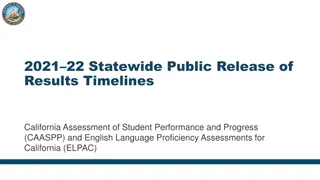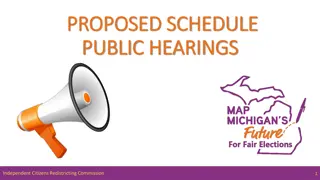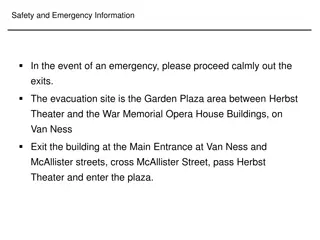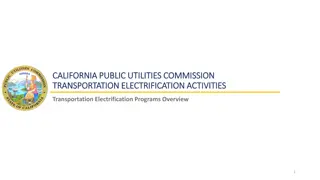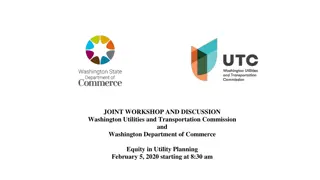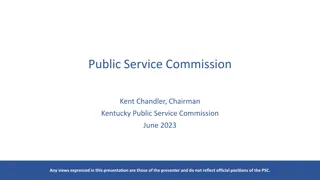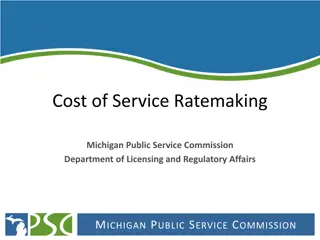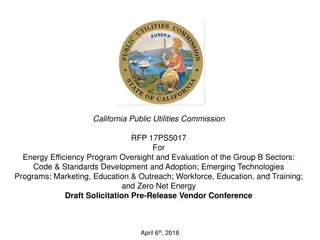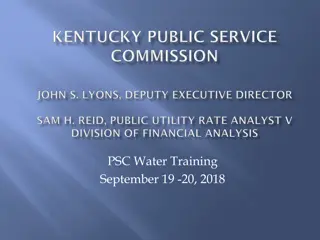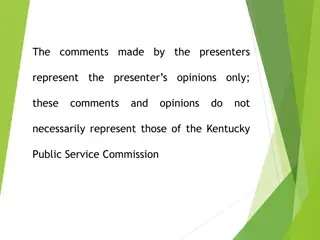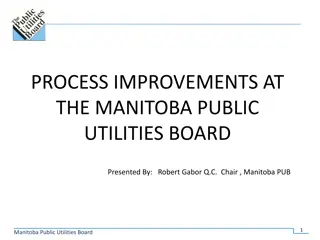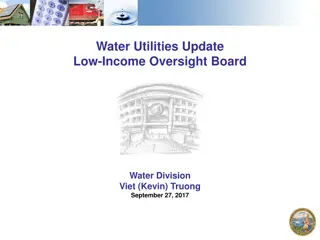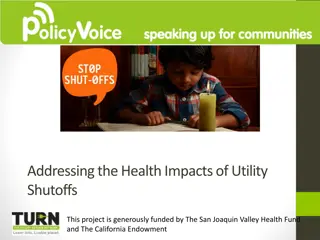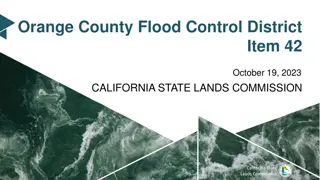Overview of California Public Utilities Commission
California Public Utilities Commission (CPUC) plays a crucial role in regulating services and utilities to protect consumers and the environment. Governed by five Commissioners, CPUC oversees various industries such as electric utilities, natural gas utilities, and more. The Energy Division focuses on key tasks like overseeing utilities, approving rates, and supporting clean energy goals. CPUC also implements policies and programs for safe and reliable utility services at reasonable rates.
Download Presentation

Please find below an Image/Link to download the presentation.
The content on the website is provided AS IS for your information and personal use only. It may not be sold, licensed, or shared on other websites without obtaining consent from the author.If you encounter any issues during the download, it is possible that the publisher has removed the file from their server.
You are allowed to download the files provided on this website for personal or commercial use, subject to the condition that they are used lawfully. All files are the property of their respective owners.
The content on the website is provided AS IS for your information and personal use only. It may not be sold, licensed, or shared on other websites without obtaining consent from the author.
E N D
Presentation Transcript
California Public Utilities Commission Energy Division Questions on General CPUC Recruitment: cpucrecruiter@cpuc.ca.gov For questions regarding energy division recruiting please contact: energydivisionrecruiting@cpuc.ca.gov California Public Utilities Commission 1
CPUC Overview Mission: The CPUC regulates services and utilities, protects consumers, safeguards the environment, and assures Californians' access to safe and reliable utility infrastructure and services at reasonable rates. Industries of Regulation Electric utilities Natural gas utilities Telecommunications Water utilities Railroad Rail transit Passenger transportation companies 2 2 California Public Utilities Commission
CPUC Overview Governed by five Commissioners serving staggered 6-year terms, appointed by Governor and with CA Senate confirmation. Sitting Gov appoints CPUC president Offices ~1,000 staff San Francisco headquarters: 805 staff Sacramento area: 63 staff, with 100 new staff planned Los Angeles: 122 staff Energy Division 212 staff in all three offices Meeting requirements Public Voting Meeting at least once a month Voting meetings generally in S.F., with occasional meetings in other CA locations 3 3 California Public Utilities Commission
CPUC Energy Division Policy considerations Key tasks Oversee investor-owned electric and natural gas utilities Approve utility rates Implement legislation Respond to public inquiries Support CPUC decision-making by drafting resolutions (regulations) and providing technical support for the Commission Load Serving Entities (LSEs) & Community Choice Aggregators (CCAs) regulatory/support services Help achieve state GHG and clean energy goals Support system safety & reliability Serve low-income and disadvantaged communities Support customer choice & distributed gen 4 4 California Public Utilities Commission https://www.cpuc.ca.gov/aboutener gy/
Key Policies & Programs CPUC tasked with assuring provision of safe, adequate, and reliable service at just and reasonable rates. Achieves this through policy initiatives and customer programs. Key CPUC policy areas Rate design Safety Investment Renewable and Clean Energy Climate Change planning Energy efficiency Demand response (electric) Energy storage California solar initiative Smart grid / Microgrid Wildfire Safety / PSPS Events Environmental and Social Justice Building Decarbonization Transportation Electrification Customer programs and assistance California Alternate Rates for Energy (CARE) Low Income Energy Efficiency Program (ESA) California Lifeline telephone Deaf and Disabled Telecommunications Program Telecommunications scam and fraud protection Assistance with formal consumer complaints 5 5 California Public Utilities Commission
CEQA The Infrastructure and California Environmental Quality Act (CEQA) unit at the CPUC provides environmental permitting and mitigation monitoring/compliance for: Transmission and Substation Projects Gas Projects Water Projects Broadband Rail Crossings The primary goal of CEQA is to: Ensure environmental consequences of decisions are meaningfully considered Lessen the impacts of projects/actions on the environment Provide transparency to both the public and decision-makers on what the environmental consequences may be and how those impacts may be avoided, minimized, and/or mitigated. California Public Utilities Commission 6
Transportation Electrification (TE) We are advancing Transportation Electrification (TE) to support California's Clean Energy Pollution Reduction Act (SB 350) and Executive Orders to ramp up zero-emission vehicles and charging infrastructure California faces ambitious TE goals pursuant to Senate Bill 350 and Executive Orders - to reduce greenhouse gas emissions by 50% from 1990 to 2030, and to require new cars sold in California to be zero-emission vehicles. In response, the Public Utilities Commission's Electrification Transportation Team and other agencies have developed programs to oversee California's goals. The TE team oversees infrastructure programs that provide subsidies and rebate structures for installing electric charging equipment and works with investor-owned utilities to expand charging stations for public use, focusing on communities with heavy pollution burdens. The TE team helps ensure EV drivers charge at the correct times of day (by reviewing new electric rates) and is implementing strategies for integrating the load from an increasing number of EVs in a way that benefits rather than causes stress to the transmission, generation, and distribution systems. California Public Utilities Commission
Transportation Electrification CPUC has approved over $1.5 billion in funding for investor- owned utilities (IOUs) to expand the State s electric vehicle charging infrastructure The chart to the right displays funds the CPUC has authorized IOUs to spend on transportation electrification investments, with approximately one- quarter of authorized ports for light- duty vehicle charging already energized. Additionally, with the medium-duty and heavy-duty transportation sector being a significant contributor to CA's greenhouse gas emissions, the CPUC is vested in providing the necessary equipment to electrify that sector, with over 300 energized ports. California Public Utilities Commission
Integrated Resource Planning (IRP) Established by Senate Bill 350 (De Le n, 2015), the objective of the CPUC s integrated resource planning proceeding is to reduce the cost of achieving greenhouse gas (GHG) reductions and other policy goals by looking across individual LSE boundaries and resource types to identify solutions to reliability, cost, or other concerns that might not otherwise be found. Goal of the 2019-21 IRP cycle is to ensure that the electric sector is on track to help California reduce economy-wide GHG emissions 40% from 1990 levels by 2030, and to explore how achievement of SB 100 2045 goals could inform IRP resource planning in the 2020 to 2030 timeframe. California today is a complex landscape for resource planning: Multiple Load Serving Entities (LSEs) including: Investor-Owned Utilities (IOUs) Community Choice Aggregators (CCAs) Energy Service Providers (ESPs) Multiple state agencies (CPUC, CEC, Air Resources Board) and CAISO. California Public Utilities Commission 9
Demand Response Demand response (DR) is a way for customers to help California manage its electricity demand. DR is customers changing their electricity usage (typically reducing use or shifting use to other times in the day) at certain times in response to economic incentives, price signals, or other conditions. Future DR may involve customers increasing their electricity usage when the grid has too much electricity generation from renewable resources like the wind or sun. Effective demand response programs provide California ratepayers with various economic and environmental benefits. These benefits include: Avoiding the construction of new power plants Avoiding the purchase of high-priced energy Providing greater reliability to the grid, which helps prevent blackouts Avoiding the consumption of fossil fuels which can damage the environment Currently, demand response programs are administered by California s three regulated investor-owned utilities: Pacific Gas & Electric, Southern California Edison and San Diego Gas & Electric. Independent commercial entities known as aggregators or Demand Response Providers may also approach customers to offer DR services. Residential, commercial, agricultural and industrial customers can all participate in demand response programs and receive incentives for doing so. California Public Utilities Commission
Customer Generation The CPUC regulates distributed generation programs and policies on both the customer and utility wholesale side of the electric meter. Customer-side of the meter distributed generation incentive programs include: Solar on Multifamily Affordable Housing Program (SOMAH) Disadvantaged Communities Single-family Solar Homes Program (DAC-SASH) Self-Generation Incentive Program These programs are overseen by the CPUC and administered through Program Administrators. Utility side of the meter distributed generation includes wholesale energy generated for sale to utilities, and these procurement programs include the renewable portfolio standard program (including competitive solicitations, feed-in tariff, and renewable auction mechanism, and other procurement mechanisms) and the combined heat and power (CHP) feed-in tariff. California Public Utilities Commission
Grid Resiliency and Microgrids A microgrid is an independent electric grid with onsite energy generation and/or storage that can operate both while connected to and when disconnected or islanded from the larger utility grid. Characteristics: Has a group of interconnected loads and distributed energy resources (DER) with clearly defined, isolatable electrical boundaries Can connect and disconnect from the grid to enable operation in both grid connected or island modes Can act as a single controllable entity with respect to the grid California Public Utilities Commission
Energy Efficiency The CPUC oversees and approves the ratepayer-funded energy efficiency (EE) programs. Energy efficiency is a cornerstone of California s energy and greenhouse gas emissions reductions efforts, and the current goal is to double the state s 2017 level of energy efficiency by 2030. The CPUC works with the investor-owned utilities, other program administrators (RENs and CCAs), and vendors to develop programs and measures to transform technology markets within California using ratepayer funds. EE Programs span across the residential, commercial, industrial and agricultural sectors. California Public Utilities Commission
Energy Efficiency California Public Utilities Commission
Energy Efficiency California Public Utilities Commission
Building Decarbonization and Renewable Gas Section Building Decarbonization activity focuses on transforming the California market for high efficiency electric heat pump appliances that run off of clean renewable electricity rather than fossil natural gas. Renewable Gas activity focuses on encouraging greater utilization of renewable gases such as biomethane, green hydrogen, and syngas as alternatives to fossil fuels. California Public Utilities Commission 16
Building Decarbonization Work Overview Specific work responsibilities include: 1. Oversight of the BUILD Program, which provides incentives to builders to build new residential homes for low-income customers that are all-electric. 2. Oversight of the TECH Initiative, which provides incentives to replace gas water heaters and furnaces with electric alternatives. 3. Oversight of the San Joaquin Valley Affordable Energy program, which provides designated communities in the Central Valley with electric heat pump appliances to use in place of propane and wood fuel. 4. Oversight of the Integrated Distributed Energy Resources process and the Avoided Cost Calculator, which help determine resource allocation and cost-effectiveness for utility programs and incentives. 5. Assistance with various other programs, incentives, and initiatives relating to electric heat pump appliances and ways to encourage building electrification (e.g., energy efficiency, rates, etc.). California Public Utilities Commission 17
Renewable Gas Work Overview Specific work responsibilities include: 1. Oversight of incentive programs designed to encourage biomethane production facilities. 2. Oversight of renewable gas interconnection rules, contract agreements, and health/safety standards. 3. Oversight of biomethane procurement program development and implementation. 4. Oversight of hydrogen injection standards and safety. 5. Assistance with hydrogen policy more generally across numerous different sections in Energy Division. California Public Utilities Commission 18
Energy Division Internships About University Enterprise Institute Most Energy Division summer internship postings available through third party portal: University Enterprises Institute 10-12 weeks, must be onsite*, paid student internships Take Action Visit UEIJobs - University Enterprises, Inc. (csus.edu) Type public utilities commission in the keywords box to search for open opportunities Create account to apply Email EDinterns@cpuc.ca.gov with questions UEIJobs - University Enterprises, Inc. (csus.edu) EDinterns@cpuc.ca.gov 19 19 California Public Utilities Commission
Energy Division Jobs About Entry, Mid level and Senior level Roles Public Utilities Regulatory Analyst (PURA) Utilities Engineer (UE) Program Project Supervisor and Program Manager Administrative and Support Staff Take action Create a CalCareer Account: https://www.jobs.ca.gov/CalHRPublic/CreateNewAccount.aspx calhr.ca.gov Review available exams: http://www.cpuc.ca.gov/jobs/ Take exam for appropriate classification and level (PURA I, II,III, or V; UE*, PPS, PM, SSA, AGPA) Once you pass the exam for that level, find relevant jobs in that level calhr.ca.gov http://www.cpuc.ca.gov/jobs/ https://www.jobs.ca.gov/CalHRPublic/CreateNewAccount.aspx 20 20 California Public Utilities Commission
Benefits CalPERS Very Competitive Health and Retirement Pension Plan Vested at 5 years* Job Security Civil Service Status Public Service Loan Forgiveness Program California Public Utilities Commission 21
What Does the Process Hiring Entail? For more information on energy division recruiting please visit: https://www.cpuc.ca.gov/about-cpuc/divisions/energy- division/energy-division-recruiting Helpful links to get started: About the CPUC (ca.gov) Current CPUC Exams How to get a state job Apply for a Job information (ca.gov) State of California Employee Benefits How to write a Statement of Qualifications SOQ 22 22 California Public Utilities Commission
How to Apply Research Positions and Apply from our CPUC website (cpuc.ca.gov) or CalHR.gov Register and apply using the Jobs or Employment link Take the Necessary Classification Exam If you have questions about a position or exam, contact: cpucrecruiter@cpuc.ca.gov Or visit: cpuc.ca.gov/jobs 23 23 California Public Utilities Commission
